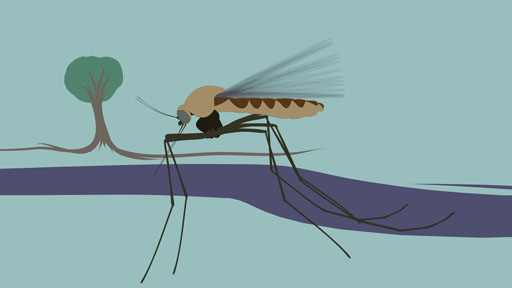1.7 Animal-to-human transmission of pathogens
Pathogens are often transmitted from animals to humans ‘accidentally’, for example via infected meat or water contaminated with animal faeces. But there are two transmission routes in which the animal is an essential agent in the transfer of pathogens to humans.
You can learn more about these in the following animation which focuses on malaria. Note that for simplicity in this animation we have referred to the pathogen that causes malaria as the ‘malaria pathogen’ or ‘malaria parasite’ but it should be remembered that the name ‘malaria’ refers to the disease and not the pathogen. The correct name for the parasite pathogen is Plasmodium and it has several different species including Plasmodium falciparum, Plasmodium vivax, Plasmodium ovale and Plasmodium malariae.

Transcript
INSTRUCTOR: Zoonoses refers to diseases that are spread from animals to humans. It's possible for humans to catch diseases from a range of invertebrate and vertebrate animals. The term vertebrate refers to animals that have a backbone, like cows, pigs, bats, and birds. The term invertebrate refers to animals that do not have a backbone, like ticks, mosquitoes, and sand flies.
It's also possible for humans to transmit diseases to animals. And in this context, the zoonosis is termed a reverse zoonosis.
The risk of infection with zoonoses increases as the human population continues to grow and people live in greater proximity to animals. While the term zoonoses applies to all diseases that are spread from animals to humans, the term vector borne diseases applies only to those spread by an intermediate carrier.
An example of an intermediate carrier is a mosquito. An example of a vector borne disease is malaria. The mosquito bites an infected animal, such as a cow shown here, and becomes a carrier of the malaria pathogen. At this point, the mosquito is referred to as a vector.
When a mosquito bites, it releases a chemical into the circulation to stop the blood clotting. During this process, it could also release one or more of the malaria parasites it has been carrying into the circulatory system of the human it has bitten. If it does this, the person becomes infected. Once in the circulation of the infected human, the malaria parasite travels to the liver and multiplies. After multiplying, the malaria circulates again in the blood.
It is possible to take action to prevent infection with the malaria parasite. For example, you can use insect repellent and you can use insect nets while sleeping. You can also avoid travelling to countries where malaria is a known risk. These are simple prevention methods that avoid contact with the vector.
[MUSIC PLAYING]
An example zoonosis that may be familiar is influenza originating in pigs (swine flu) or poultry (bird flu). The influenza viruses that cause these diseases can sometimes be transmitted from animals to humans during the slaughter or handling of livestock. Some zoonotic [zoo-not-tik] influenza viruses pose a much greater health risk than the airborne seasonal influenza viruses that commonly circulate in human populations every winter.
Can you think of any other zoonoses that have made news headlines, at least in the UK?
You may recall that cattle can be infected with the bacteria that cause tuberculosis (TB), which can then be transmitted to humans. Badgers can also host TB bacteria, although there are no known cases of badger-to-human transmission. The mosquito borne Zika virus has also made news headlines because of its increasing incidence and the effects that have been observed on babies whose mothers have been infected. This virus may have originally been transmitted to the human population from monkeys.
A zoonosis that is well known in India and some other parts of the world is rabies [ray-beez]. The rabies virus can infect many warm-blooded vertebrates including squirrels, raccoons and bats, but the main route of transmission to humans is via dogs. Every year, over 3000 people in India die from rabies transmitted by a dog bite (Figure 9). The majority of these deaths are among children because they are more likely to try to play with unfamiliar dogs (Chatterjee, 2009).

Another route of transmission from animals to humans results in vector-borne infections. They differ from zoonoses in that they are transmitted by an invertebrate animal (without a backbone), mainly biting insects and ticks. The term ‘vector’ [vek-torr] comes from the Latin word for ‘carrier’, so in this context it means a carrier of an infectious disease. The pathogen must complete part of its life cycle in the vector, so transmission to humans may be prevented if the vectors can be killed. For example, Lyme disease is caused by a bacteria transmitted from birds or small mammals (such as deer) to humans by a type of tick.
Can you suggest why aeroplane cabins are sprayed with insecticide before take-off from a country where malaria is common?
The spray is to kill any mosquitoes that may have got onto the plane in the clothing or luggage of passengers. Mosquitoes are the vectors of malaria and transmit the pathogen when they bite humans to take a blood meal.
There are many other vector-borne infections, including bubonic plague [byoo-bon-nik playgg] transmitted by rat fleas, typhus [ty-fuss] transmitted by ticks, and yellow fever transmitted by mosquitoes. In 2014, the World Health Organization (WHO, pronounced ‘double-you-haitch-oh’ rather than ‘who’) – the branch of the United Nations responsible for coordinating and directing international policy and actions on health – devoted its annual ‘World Health Day’ to publicise the risk from vector-borne infections (Figure 10).

